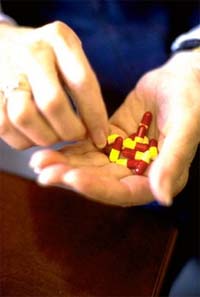
|
AIDS Treatment News
 New HIV treatment guidelines for adults and adolescents,
developed by a panel of experts convened by the U.S. Department
of Human Services, were published July 14, 2003. This standard
differs from previous editions in giving more direction to
physicians, especially in choosing specific drugs. You can
download this and other guidelines documents at
http://AIDSinfo.nih.gov -- click Guidelines, then Adult and
Adolescent Guidelines.
New HIV treatment guidelines for adults and adolescents,
developed by a panel of experts convened by the U.S. Department
of Human Services, were published July 14, 2003. This standard
differs from previous editions in giving more direction to
physicians, especially in choosing specific drugs. You can
download this and other guidelines documents at
http://AIDSinfo.nih.gov -- click Guidelines, then Adult and
Adolescent Guidelines.
Advice on when to start antiretrovirals has not changed. But instead of the previous system (pick one drug from column A and two from column B), the new guidelines recommend choosing one of basically two preferred regimens, with alternates available if needed. There is also more guidance for doctors on how to deal with drug failure and choosing a new regimen. Much of the useful information is contained in the 29 tables at the end of the 96-page document. Comment Guidelines are never the final word in a complicated, fast- changing, and controversial area of medicine. It is still critically important to have the advice of a physician with extensive experience in treating HIV. HIV Drugs Approved as of August 2003 Here are all the antiretroviral drugs approved in the U.S. at the end of July 2003. We list them by drug class: * NRTIs (nucleoside reverse transcriptase inhibitor) target reverse transcriptase (an enzyme of HIV), by providing false building blocks that the enzyme puts into new copies of the virus it is building. Occasionally the false building blocks can be incorporated into human DNA, causing toxicity. * NNRTIs (non-nucleoside reverse transcriptase inhibitor) target the same reverse transcriptase enzyme, but do not provide false building blocks. * Protease inhibitors target HIV protease, an enzyme necessary for late steps in the formation of new copies of HIV. Some protease inhibitors may inhibit certain human proteases as well, causing toxicity. * Fusion inhibitors block infection early by preventing HIV from fusing with and entering a human cell. Only one fusion inhibitor has been approved so far, and this particular drug is expensive to manufacture and difficult to use. None of these drugs can be taken alone to treat an established HIV infection. They must be used in well-designed combination regimens. NRTIs: Abacavir (Ziagen) Didanosine - ddI (Videx) Emtricitabine - FTC (Emtriva -- previous brand name Coviracil) Lamivudine - 3TC (Epivir) Stavudine - d4T (Zerit) Tenofovir DF (Viread) Zalcitabine - ddC (Hivid,) Zidovudine - AZT (Retrovir) NNRTIs Delavirdine (Rescriptor) Efavirenz (Sustiva, brand name Stocrin in many countries) Nevirapine (Viramune) PROTEASE INHIBITORS: Amprenavir (Agenerase) Atazanavir (Reyataz, formerly named Zrivada) Indinavir (Crixivan) Lopinavir+ritonavir (Kaletra) Nelfinavir (Viracept) Ritonavir (Norvir) Saquinavir (Fortovase, earlier formulation Invirase) FUSION INHIBITORS: Enfuvirtide (Fuzeon) Combination Medications These brand names are combinations of two or three of the medicines above in one pill. Combinations reduce the number of pills patients must take each day. They can also help meet requirements of health plans that limit the number of "prescriptions" per month regardless of medical need. Combivir (AZT + 3TC) Trizivir (abacavir + AZT + 3TC) AIDS Treatment News Published twice monthly Subscription and Editorial Office: 1233 Locust St., 5th floor Philadelphia, PA 19107 800/TREAT-1-2 toll-free email: aidsnews@critpath.org useful links: http://www.aidsnews.org/ Editor and Publisher: John S. James Associate Editor: Tadd T. Tobias Statement of Purpose: AIDS Treatment News reports on experimental and standard treatments, especially those available now. We interview physicians, scientists, other health professionals, and persons with AIDS or HIV; we also collect information from meetings and conferences, medical journals, and computer databases. Long-term survivors have usually tried many different treatments, and found combinations that work for them. AIDS Treatment News does not recommend particular therapies, but seeks to increase the options available. AIDS Treatment News is published 24 times per year, on the first and third Friday of every month, and print copies are sent by first class mail. Email is available (see below). Back issues are available at http://www.aidsnews.org/ To subscribe, you can call 800-TREAT-1-2 or 415-255-0588: |